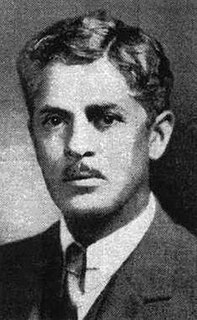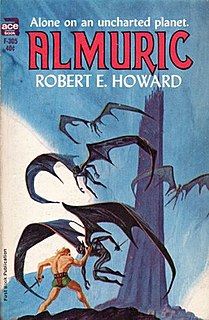
Edgar Rice Burroughs was an American author, best known for his prolific output in the adventure, science fiction, and fantasy genres. Most well-known for creating the characters Tarzan and John Carter, he is also known for writing the Pellucidar series, the Amtor series, and the Caspak trilogy.
Pulp magazines were inexpensive fiction magazines that were published from 1896 to the late 1950s. The term "pulp" derives from the cheap wood pulp paper on which the magazines were printed. In contrast, magazines printed on higher-quality paper were called "glossies" or "slicks". The typical pulp magazine had 128 pages; it was 7 inches (18 cm) wide by 10 inches (25 cm) high, and 0.5 inches (1.3 cm) thick, with ragged, untrimmed edges.

Murray Leinster was a nom de plume of William Fitzgerald Jenkins, an American writer of genre fiction, particularly of science fiction. He wrote and published more than 1,500 short stories and articles, 14 movie scripts, and hundreds of radio scripts and television plays.

Sam Youd, was a British writer, best known for science fiction written under the name of John Christopher, including the novels The Death of Grass, The Possessors, and the young-adult novel series The Tripods. He won the Guardian Children's Fiction Prize in 1971 and the Deutscher Jugendliteraturpreis in 1976.

Robert William Chambers was an American artist and fiction writer, best known for his book of short stories titled The King in Yellow, published in 1895.

Abraham Grace Merritt – known by his byline, A. Merritt – was an American Sunday magazine editor and a writer of fantastic fiction.
Argosy, later titled The Argosy, Argosy All-Story Weekly and The New Golden Argosy, was an American pulp magazine from 1882 through 1978, published by Frank Munsey until its sale to Popular Publications in 1942. It is the first American pulp magazine. The magazine began as a children's weekly story–paper entitled The Golden Argosy. In the era before the Second World War, Argosy was regarded as one of the "Big Four" pulp magazines, the most prestigious publications in the pulp market, that many pulp magazine writers aspired to publish in. John Clute, discussing the American pulp magazines in the first two decades of the twentieth century, has described The Argosy and its companion The All-Story as "the most important pulps of their era."

Otis Adelbert Kline born in Chicago, Illinois, USA, was a songwriter, an adventure novelist and literary agent during the pulp era. Much of his work first appeared in the magazine Weird Tales. Kline was an amateur orientalist and a student of Arabic, like his friend and sometime collaborator, E. Hoffmann Price.

Railroad Magazine was a pulp magazine founded by Frank Anderson Munsey and published October 1906 to January 1979. It was the first specialized pulp magazine with stories and articles about railroads. The magazine merged with Railfan to form the new Railfan & Railroad, published by Carstens Publications beginning after the final Railroad issue in 1979.

Ray Cummings was an American author of science fiction literature and comic books.

Victor Rousseau Emanuel was a British writer who wrote novels, newspaper series, science fiction and pulp fiction works. He was active in Great Britain and the United States during the first half of the 20th century.

Blue Book was a popular 20th-century American magazine with a lengthy 70-year run under various titles from 1905 to 1975. It was a sibling magazine to The Red Book Magazine and The Green Book Magazine.

The Metal Monster is a fantasy novel by American writer Abraham Merritt. It was first serialized in Argosy All-Story Weekly in 1920 and features the return of Dr. Goodwin who first appeared in The Moon Pool.

Gertrude Barrows Bennett, known by the pseudonym Francis Stevens, was a pioneering author of fantasy and science fiction. Bennett wrote a number of fantasies between 1917 and 1923 and has been called "the woman who invented dark fantasy".

Viña Delmar was an American short story writer, novelist, playwright, and screenwriter who worked from the 1920s to the 1970s. She rose to fame in the late 1920s with the publication of her suggestively titled novel, Bad Girl, which became a bestseller in 1928. Delmar also wrote the screenplay to the screwball comedy, The Awful Truth, for which she received an Academy Award nomination in 1937.

People of the Comet is a science fiction novel by American writer Austin Hall. It was first published in book form in 1948 by Griffin Publishing Company in an edition of 900 copies. The novel was originally serialized in two parts in the magazine Weird Tales beginning in September 1923. The author's own title for the novel was Hop O' My Thumb.

Almuric is a science fiction novel by American writer Robert E. Howard. It was originally serialized in three parts in the magazine Weird Tales beginning in May 1939. The novel was first published in book form in 1964 by Ace Books.

Famous Fantastic Mysteries was an American science fiction and fantasy pulp magazine published from 1939 to 1953. The editor was Mary Gnaedinger. It was launched by the Munsey Company as a way to reprint the many science fiction and fantasy stories which had appeared over the preceding decades in Munsey magazines such as Argosy. From its first issue, dated September/October 1939, Famous Fantastic Mysteries was an immediate success. Less than a year later, a companion magazine, Fantastic Novels, was launched.

Fantastic Novels was an American science fiction and fantasy pulp magazine published by the Munsey Company of New York from 1940 to 1941, and again by Popular Publications, also of New York, from 1948 to 1951. It was a companion to Famous Fantastic Mysteries. Like that magazine, it mostly reprinted science fiction and fantasy classics from earlier decades, such as novels by A. Merritt, George Allan England, and Victor Rousseau, though it occasionally published reprints of more recent work, such as Earth's Last Citadel, by Henry Kuttner and C. L. Moore.

The Planet of Peril, later republished as Planet of Peril, is a 1929 science fiction novel by Otis Adelbert Kline. Originally serialized in six parts in Argosy All-Story Weekly during the summer of 1929, it was published in hardcover later that year by A. C. McClurg and reissued in a lower-price edition by Grosset & Dunlap. It was revived in 1961 as an Avalon Books hardcover and saw its only mass market paperback edition from Ace Books in 1963. The later editions, well after Kline's death, were revised and shortened.


















